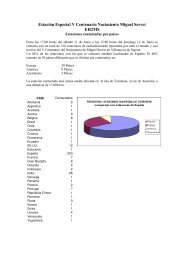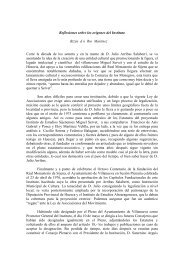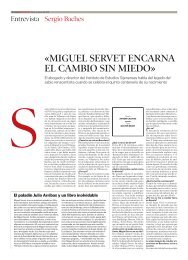New Page
New Page
New Page
Create successful ePaper yourself
Turn your PDF publications into a flip-book with our unique Google optimized e-Paper software.
PREFACE<br />
It is a well-known fact that two regions of Eastern Central Europe, Poland and Transylvania,<br />
played outstandingly important roles in the history of sixteenth and seventeenth century<br />
Antitrinitarianism. It is another fact that the developments in Poland are much better known for European<br />
scholars of the subject than those in Transylvania. One of the most important causes of this deplorable<br />
situation might be that Hungarian scholarship in the last century has not exerted continued and organized<br />
efforts in order to make Transylvanian developments known for international scholarship. While in<br />
Poland Stanislaw Kot and his disciples, then members of the younger generation regarded it as their<br />
important task to elaborate what role Polish heterodoxy and particularly seventeenth century Socinianism<br />
had played in the history of European thought, researches in Hungary could be described as introverted.<br />
However, some changes are visible in this area. The intent to change is demonstrated by starting<br />
the series Bibliotheca Antitrinitariorum, as well as the volumes of Bibliotheca Dissidentium published so<br />
far, and the present work intends to be part of the same effort. Thus, its most important goal is to offer a<br />
summary of the earliest period of Transylvanian Antitrinitarianism that contains the results of the<br />
international researches of the last decades and also all that Hungarian scholarship has produced.<br />
This alone would justify concentrating attention on the late 1560s, that is to say, on the years that<br />
saw the rise of Transylvanian Antitrinitarianism; but this decision is supported by further scientific<br />
historical considerations.1 Antal Pirnát's monograph in German,2 which demonstrated on a so far<br />
completely unknown manuscript material the activities of the Antitrinitarians in Transylvania, has had a<br />
profound influence of subsequent studies. The work focussed attention on the trend that unfolded in the<br />
1570s, called dogmatically radical in the literature on the subject, source publications and treatments of<br />
the representatives of this trend (J. Sommer, J. Palaeologus, M. Vehe-Glirius, Ferenc Dávid, Ch.<br />
Francken) following in suit in great numbers.3 These works have considerably enriched and, on a number<br />
of points, modified the statements of Pirnát's book, which was the first to describe those so far unknown<br />
records. The bulk of these works concentrated, as a matter of course, on the 1570s and 1580s, and thus the<br />
period of the development of Transylvanian Antitrinitarianism when its products could be published in<br />
print and distributed for the European public was neglected. Let us add that this was the period when<br />
Ferenc Dávid, the most important representative of the movement in Transylvania, wrote most of his<br />
works.<br />
It is no wonder, then, that the abundant literature on the subject has failed even to ask the question<br />
that the present work is endeavouring to answer. For what I have tried to examine is why Transylvania<br />
became the centre of this dogmatic radicalism, and whether the Transylvanian Antitrinitarianism of the<br />
1560s displays any peculiarities that could explain this phenomenon.<br />
What particularly justifies for me the formulation of this question is that I do not find the picture<br />
emerging from the studies that do treat the Transylvanian Antitrinitarianism of the 1560s satisfactory. To<br />
put it somewhat simply, we can discern two tendencies. One can see no difference between the ecclesia<br />
minor in Poland and the Antitrinitarianism unfolding in other parts of Europe and the Transylvanian<br />
developments of the period under discussion. According to this view, the Transylvanian phenomena<br />
smoothly fit into the current called Anabaptistic Antitrinitarianism, without exciting dissimilarities or<br />
local peculiarities.4 The other, radically different view, on the other hand, puts the emphasis on<br />
continuity, essentially projecting the image of the 1570s, without any problems, back to the period<br />
discussed below.5 The great problem of this view is that it cannot handle the fact that it was precisely in<br />
Transylvania that the most important Latin works of the so-called Anabaptist Antitrinitarianism were<br />
published in print.<br />
2







